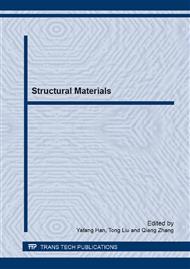p.340
p.346
p.351
p.357
p.362
p.367
p.372
p.378
p.384
Working Hardening Mechanism and Aging Treatment Behaviors of D631 Precipitation Hardening Stainless Steel Wire
Abstract:
Precipitation hardening stainless steel has the advantages of both austenitic stainless steel and martensitic stainless steel, including good corrosion resistance, excellent processability and high strength. With the evolution of microstructure and properties of semi-austenitic precipitation hardening stainless steel (D631) during drawing process and aging treatment, the working hardening behaviors, law of phase transition, dissolution and precipitation state of alloying element are investigated to gain the toughness mechanism of D631. The results show that the tensile strength increases with the increase of the reduction of area, on the contrary, the plasticity decreases gradually. The tensile strength is 1529 MPa while the reduction of area is 54%. By means of X-ray diffraction (XRD) and metallograpic observation, the content of martensite increases with the increase of deformation, and makes the higher strength and lower plasticity. The alloying element dissolved in the matrix precipitates in fine particles by aging treatment, resulting in a higher strength of 1948MPa.
Info:
Periodical:
Pages:
362-366
Citation:
Online since:
April 2014
Authors:
Price:
Сopyright:
© 2014 Trans Tech Publications Ltd. All Rights Reserved
Share:
Citation:


